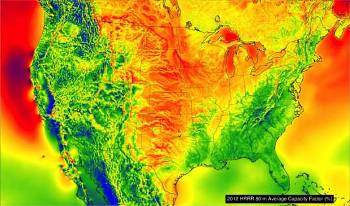Jan 28 2016
Within 15 years the United States will be able to bring down greenhouse gas emissions caused by power production by up to 78% below the levels in 1990, and still fulfill the increased power demand.
 A high-resolution map based on NOAA weather data shows a snapshot of wind energy potential across the United States in 2012. Image by Chris Clack/CIRES.
A high-resolution map based on NOAA weather data shows a snapshot of wind energy potential across the United States in 2012. Image by Chris Clack/CIRES.
This revelation is based on a new study by the National Oceanic and Atmospheric Administration (NOAA) and University of Colorado Boulder researchers.
This study used a high-tech mathematical model for evaluating future cost, power demand, and power generation and transmission scenarios. They found that with advances in transmission infrastructure, the country’s electricity demand can be met with the weather-driven renewable energy resources at current costs.
Our research shows a transition to a reliable, low-carbon, electrical generation and transmission system can be accomplished with commercially available technology and within 15 years.
Alexander MacDonald, Co-Lead Author
The research paper is published online today in Nature Climate Change.
Although improvements in solar and wind generation have reduced renewable energy production costs, continuous production is a concern for such energy resources. Utilities have provided surplus generation capacity as a backup for renewable energy generation, by installing natural gas-fired generators and other reserves.
In the future, they may not need to.
Christopher Clack, Co-Lead Author
Since it is always sunny or windy somewhere in the United States, MacDonald suggested that to resolve the intermittent renewable generation problem, the renewable energy generation system could be scaled-up in tune with the weather systems.
For over 40 years MacDonald has been studying and working to improve weather forecasts. He assembled a group of four other NOAA scientists to explore his theory. Using NOAA’s high-resolution meteorological data, the group built a model for evaluating the cost of integrating various electricity sources into a national energy system. The model provides an estimate of the renewable resource potential, energy demand, carbon dioxide (CO2) emissions, and the expansion and operational costs of electricity generation and transmission systems to satisfy future needs.
The model allowed researchers to evaluate the reliability, affordability, and greenhouse gas emissions of different energy mixes, including coal. It demonstrated that low emissions and low costs need not be mutually exclusive.
The model relentlessly seeks the lowest-cost energy, whatever constraints are applied, and it always installs more renewable energy on the grid than exists today.
Christopher Clack, Co-Lead Author
Even if the renewable energy cost is more than the predicted cost, the model provides a system that reduces CO2 emissions by 33% below the levels in 1990 by the year 2030, and delivered electricity at around 8.6 cents per kWh. The cost of electricity in 2012 was 9.4 cents per kWh.
If natural gas costs were higher and renewable energy costs lower, as predicted, the model cuts down CO2 emissions by 78% from the 1990 levels, and offered electricity at 10 cents per kWh. The year 1990 is taken as a standard benchmark for greenhouse gas analysis.
One of the scenarios included coal that yielded a lower cost (8.5 cents per kWh), but accounts for the highest emissions.
At the recent Paris climate summit, the United States promised to cut greenhouse emissions by up to 28% below the 2005 levels from all sectors, by the year 2025. The research paper suggests the country will be able to cut total CO2 emissions by 31% below the 2005 levels by the year 2030 by making changes only in the electric sector, even though this sector accounts for only 38% of the national CO2 budget. These changes include rapid expansion of renewable energy generation, and improvements in transmission infrastructure.
To discover low-cost solutions, the researchers enabled used the model to consider the costs for transmission infrastructure improvements—particularly a new, high-voltage direct-current (HVDC) transmission grid to support the present electrical grid. HVDC lines reduce energy losses in long-distance transmission. The model chose to extensively use the HVDC lines, and the study realized that investing in efficient, long-distance transmission is vital for keeping down the costs.
MacDonald likened the idea of the HVDC grid with the country’s interstate highway system that transformed the U.S. economy in the 1950s.
With an ‘interstate for electrons’, renewable energy could be delivered anywhere in the country while emissions plummet. A HVDC grid would create a national electricity market in which all types of generation, including low-carbon sources, compete on a cost basis. The surprise was how dominant wind and solar could be.
Alexander MacDonald, Co-Lead Author
The new mathematical model has gained interest from other experts as well.
This study pushes the envelope. It shows that intermittent renewables plus transmission can eliminate most fossil-fuel electricity while matching power demand at lower cost than a fossil fuel-based grid – even before storage is considered.
Mark Jacobson, Stanford University